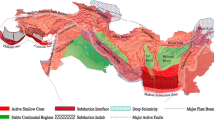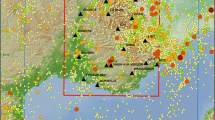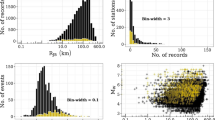Abstract
Scherbaum et al. [(2004) Bull Seismolo Soc Am 94(6): 2164–2185] proposed a likelihood-based approach to select and rank ground-motion models for seismic hazard analysis in regions of low-seismicity. The results of their analysis were first used within the PEGASOS project [Abrahamson et al. (2002), In Proceedings of the 12 ECEE, London, 2002, Paper no. 633] so far the only application of a probabilistic seismic hazard analysis (PSHA) in Europe which was based on a SSHAC Level 4 procedure [(Budnitz et al. 1997, Recommendations for PSHA: guidance on uncertainty and use of experts. No. NUREG/CR-6372-V1). The outcome of this project have generated considerable discussion (Klügel 2005, Eng Geol 78:285–307, 2005b) Eng Geol 78: 285–307, (2005c) Eng Geol 82: 79–85 Musson et al. (2005) Eng Geol 82(1): 43–55]; Budnitz et al. (2005), Eng Geol 78(3–4): 285–307], a central part of which is related to the issue of ground-motion model selection and ranking. Since at the time of the study by Scherbaum et al. [(2004.) Bull Seismolo Soc Am 94(6): 2164–2185], only records from one earthquake were available for the study area, here we test the stability of their results using more recent data. Increasing the data set from 12 records of one earthquake in Scherbaum et al. [(2004) Bull Seismolo Soc Am 94(6): 2164–2185] to 61 records of 5 earthquakes, which have mainly occurred since the publication of the original study, does not change the set of the three top-ranked ground-motion models [Abrahamson and Silva (1997) Seismolo Res Latt 68(1): 94–127; Lussou et al. (2001) J Earthquake Eng 5(1):13–33; Berge-Thierry et al. (2003) Bull Seismolog Soc Am 95(2): 377–389. Only for the lower-ranked models do we obtain modifications in the ranking order. Furthermore, the records from the Waldkirch earthquake (Dec, 5th, 2004, M w = 4.9) enabled us to develop a new stochastic model parameter set for the application of Campbell’s [(2003) Bull Seismolo Soc Am 93(3): 1012–1033] hybrid empirical model to SW Germany and neighbouring regions.
Similar content being viewed by others
References
Abrahamson NA, Birkhauser P, Koller M, Mayer-Rosa D, Smit PM, Sprecher C, Tinic S, Graf R (2002) PEGASOS- A comprehensive probabilistic seismic hazard assessment for nuclear power plants in Switzerland. In: Proceedings of the 12 ECEE, London, 9–13 September 2002, paper no. 633
Abrahamson NA, Silva WJ (1997) Empirical response spectral attenuation relations for shallow crustal earthquakes. Seismolo Res Lett 68(1):94–127
Ambraseys N, Douglas J, Sarma SK, Smit PM (2005) Equations for the estimation of strong ground motions from shallow crustal earthquakes using data from Europe and the middle east: horizontal peak ground acceleration and spectral acceleration. Bull. Earthquake Eng. 3(1): 1–53
Ambraseys N, Simpson K, Bommer JJ (1996) Prediction of horizontal response spectra in Europe. Earthquake Eng Struct Dyn 25:371–400
Atkinson GM, Boore DM (1997) Some comparisons between recent ground motion relations. Seismolo Res Lett 68(1):24–40
Bay F, Fäh D, Malagnini L, Giardini D (2003) Spectral shear-wave ground motion scaling in Switzerland. Bull. Seismolo. Soc. Am. 93(1):414–429
Berge-Thierry C, Cotton F, Scotti O, Griot-Pommera G-A, Fukushima Y (2003) new empirical response spectral attenuation laws For moderate european Earthquakes. J Earthquake Eng 7(2):193–222
Bommer JJ, Scherbaum F, Bungum H, Cotton F, Sabetta F, Abrahamson NA (2005) On the use of logic trees for ground-motion prediction equations in seismic hazard analysis. Bull Seismolo Soc Am 95(2):377–389
Boore DM (1983) Stochastic simulation of high-frequency ground motions based on seismological models of the radiated spectra. Bull Seismolo Soc Am 73(6):1865–1894
Boore DM (2002) SMSIM - Fortran programs for simulating ground motions from earthquakes: Version 2.0—a revision of OFR 96-80-A. Open file report, US Geological Survey
Boore DM (2003) Simulation of ground motions using the stochastic method. Pure Appl Geophys 160:635–676
Boore DM, Joyner WB, Fumal TE (1997) Equations for estimating horizontal response spectra and peak acceleration from western north American earthquakes: a summary of recent work. Seism Res Lett 68(1):128–153
Bragato PL, Slejko D (2005) Empirical Ground-motion attenuation relations for the Eastern alps in the magnitude range 2. 5–6.3. Bull Seismolo Soc Am 95(1):252–276
Braunmiller J, Kradolfer U, Baer M, Giardini D (2002) Regional moment determination in the european-mediterranean region—inital results. Tectonophysics 356:5–22
Budnitz RJ, Apostolakis G, Boore DM, Cluff LS, Coppersmith KJ, Cornell CA, Morris PA (1997) recommendations for PSHA: guidance on uncertainty and use of experts. NUREG/CR-6372, vol 1. US Nuclear Regulatory commission, Washington, DC. TIC: 235076
Budnitz RJ, Cornell CA, Morris PA (2005) Discussion of “problems in the application of the SSHAC probability method for assessing earthquake hazards at Swiss nuclear power plants”. Eng Geol 78(3–4):285–307; Eng Geol 82(1):76–78
Campbell KW (2003) Prediction of strong ground motion using the hybrid empirical method and its use in the development of ground motion (Attenuation) relations in eastern north America. Bull Seismol Soc Am 93(3):1012–1033
Campbell KW, Bozorgnia Y (2003) Updated near-source ground-motion (Attenuation) relations for the horizontal and vertical components of peak ground acceleration and acceleration response spectra. Bull Seismol Soc Am 93(1):314–331
Cotton F, Scherbaum F, Bommer JJ, Bungum H (2006) Criteria for selecting and adjusting ground motion models for specific target regions: applicaiton to central europe and rock sites. J Seismology (in press). doi:10.1007/s10950-005-9006-7
Goldberg DE (1989) Genetic algorithms in search, optimization and machine learning. Addison-Wesley Publishing Company Inc., Reading, MA
Goutbeek F, Dost B, van Eck T (2004) Intrinsic absorption and scattering attenuation in the southern part of the Netherlands. J Seismol 8:11–23
Hanks T (1979) B Values and ω2 seismic source models: implications for tectonic stress variations along active crustal fault zones and the estimation of High-frequency strong ground motion. J Geophys Res 84:2235–2242
Hanks T, McGuire R (1981) The character of high-frequency strong ground motion. Bull Seismolo Soc Am 71:2071–2095
Klügel J-U (2005a) Problems in the application of the SSHAC probability method for assessing earthquake hazards at Swiss nuclear power plants. Eng Geol 78:285–307
Klügel J-U (2005b) Reply to the comment on J. U. Klügel’s “Problems in the application of the SSHAC probability method for assessing earthquake hazards at Swiss nuclear power plants”. Eng Geol 78:285–307, by Musson et al. Eng Geol 82(1):56–65
Klügel J-U (2005c) Reply to the comment on J.U. Klügel’s “Problems in the application of the SSHAC probability method for assessing earthquake hazards at Swiss nuclear power plants”. Eng Geolo 78:285–307, by Budnitz, by Klügel JU Eng Geolo 82(1):79–85
Lussou P, Bard P, Cotton F, Fukushima Y (2001) Seismic design regulation codes: contribution of K-Net data to site effect evaluation. J Earthquake Eng 5(1):13–33
McGuire R, Hanks T (1980) RMS Accelerations and spectral amplitudes of strong ground motion during the San Fernando, California, earthquake. Bull Seismol Soc Am 70:1907–1919
Musson RMW, Toro GR, Coppersmith KJ, Bommer JJ, Deichmann N, Bungum H, Cotton F, Scherbaum F, Abrahamson NA (2005) Evaluating hazard results for Switzerland and how not to do it: A discussion of “Problems in the application of the SSHAC probability method for assessing earthquake hazards at Swiss nuclear power plants” by J-U Klügel. Eng Geol 82(1):43–55
Oncescu M-C, Camelbeeck T, Martin H (1994) Source parameters for the Roermond aftershocks of 1992 April 13 – May 2 dan site spectra for P and S waves at the Belgian seismic network. Geophys J Int 116:673–682
Sabetta F, Pugliese A (1996) Estimation of response spectra and simulation of nonstationary earthquake ground motions. Bull of the Seismol Soc Am 86(2):337–352
Scherbaum F, Bommer JJ, Bungum H, Cotton F, Abrahamson NA (2005) Composite ground-motion models and logic trees: methodology, sensitivities and uncertainties. Bull Seismol Soc Am 95(5):1575–1593
Scherbaum F, Cotton F, Smit P (2004) On the use of response spectral reference data for the selection and ranking of ground-motion models for seismic hazard analysis in regions of moderate seismicity: the case of rock motion. Bull Seismol Soc Am 94(6):2164–2185
Scherbaum F, Cotton F, Staedtke H (2006) The estimation of minimum-misfit stochastic models from empirical prediction equations. Bull Seismol Soc Am 96(2):427–445
Somerville P, Collins N, Abrahamson NA, Graves M, Saikia C (2001) Ground motion attenuation relations for the central and eastern united states. Final report, award #No 99hqgr0098, US Geological Survey
Spudich P, Joyner W, Lindh AG, Boore DM, Margaris BM, Fletcher JB (1999) SEA99: a Revised found motion prediction relation for use in extensional tectonic regimes. Bull Seismol Soc Am 89(5):1156–1170
Stepp JC, Wong I, Whitney J, Quittemeyer R, Abrahamson NA, Toro GR, Youngs R, Coppersmith K, Savy J, Sullivan T, Yucca Mountain PSHA Project Members (2001) probabilistic seismic hazard analyses for ground motions and fault displacements at Yucca Mountain, Nevada. Earthquake Spectra 17:113 –151
Toro GR, Abrahamson NA, Schneider JF (1997) Model of strong ground motions from earthquakes in central and eastern north america: best estimates and uncertainties. Seism Res Lett 68(1):41–57
Author information
Authors and Affiliations
Corresponding author
Rights and permissions
About this article
Cite this article
Hintersberger, E., Scherbaum, F. & Hainzl, S. Update of likelihood-based ground-motion model selection for seismic hazard analysis in western central Europe. Bull Earthquake Eng 5, 1–16 (2007). https://doi.org/10.1007/s10518-006-9018-x
Received:
Accepted:
Published:
Issue Date:
DOI: https://doi.org/10.1007/s10518-006-9018-x




